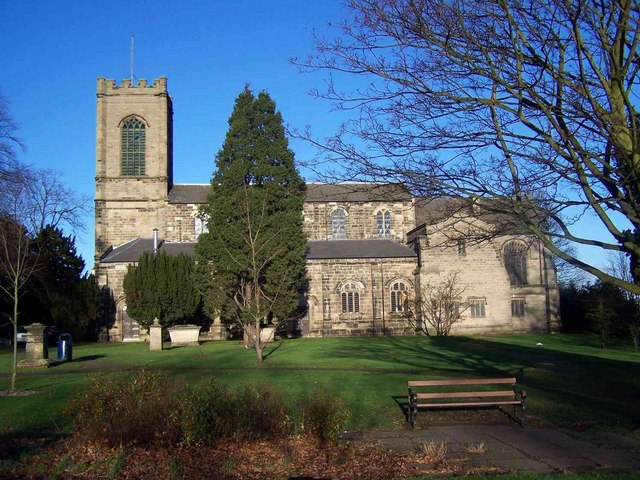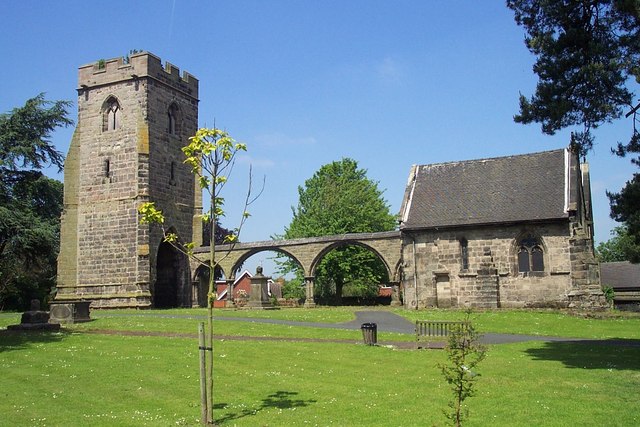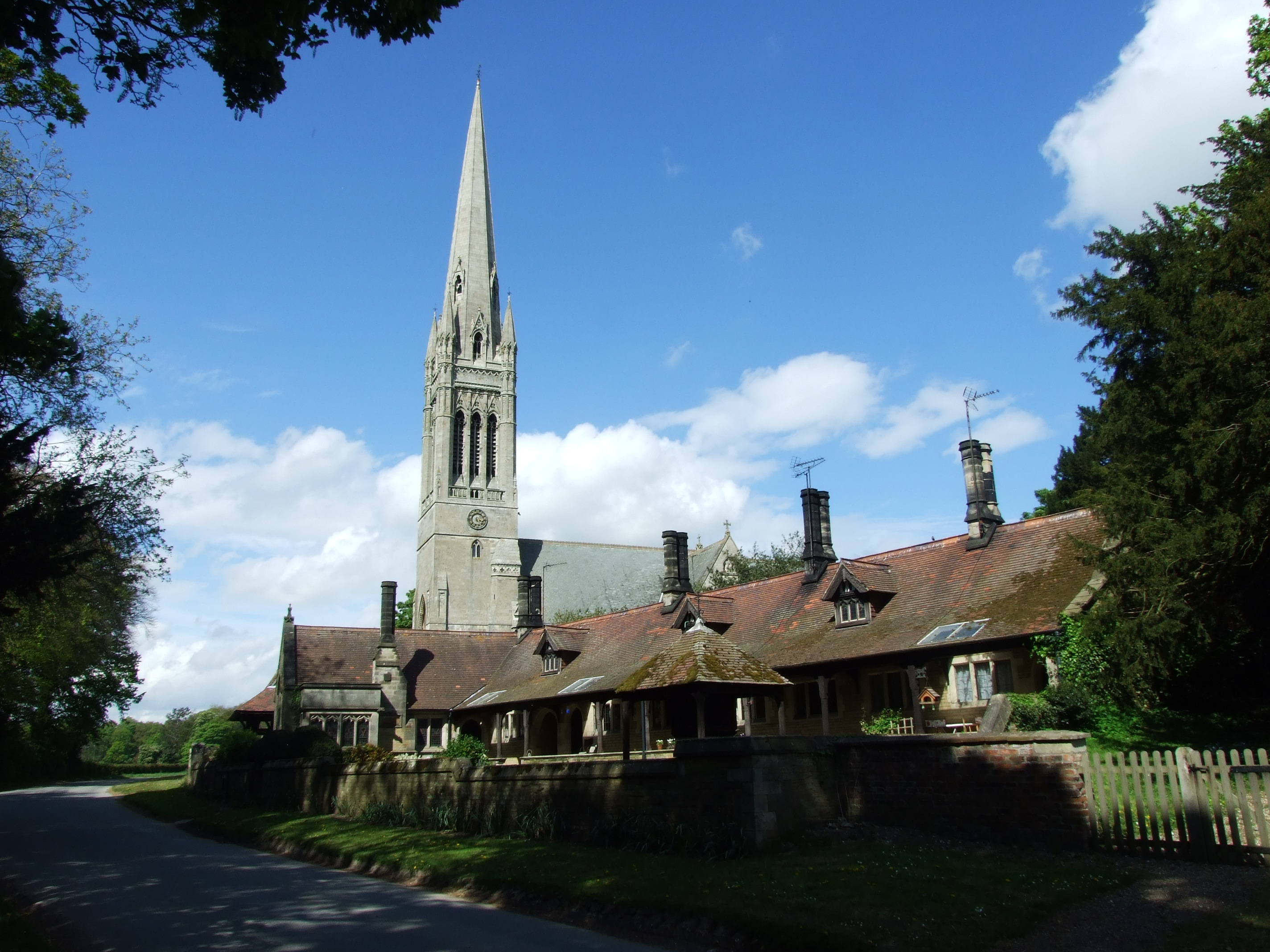|
St Augustine's Church, Rugeley
St Augustine's Church is the parish church of Rugeley in Cannock Chase District, Staffordshire, England. Located north of the town centre, it was consecrated in 1823 as a replacement for the medieval St Augustine's church, now partially ruined, and was subsequently extended. It is a Grade II* listed building. History St. Augustine's Church was built in 1822–23 to replace the medieval parish church dedicated to St Augustine of Canterbury, which had become too small for the growing population of the town. A site across the street was provided by the First Earl of Lichfield. The building was designed by H. J. Underwood and cost £6,501, some of which was later defrayed by partially demolishing the old church and selling materials from it. A chancel designed by Frank L. Pearson was added c. 1904 to accommodate a choir and a larger altar. The church was Grade II* listed on 5 July 1972. The remnant of the old church was Grade II listed on the same day. Church St Augustine's ... [...More Info...] [...Related Items...] OR: [Wikipedia] [Google] [Baidu] |
Rugeley
Rugeley ( ) is a market town and civil parish in the Cannock Chase District in Staffordshire, England. It lies on the north-eastern edge of Cannock Chase next to the River Trent; it is situated north of Lichfield, south-east of Stafford, north-east of Hednesford and south-west of Uttoxeter. At the 2021 Census, the population was 24,386. Rugeley is twinned with Western Springs, Illinois and, in July 1962, the towns made telephone history on national television when the chairman of Rugeley Urban District Council made the first telephone call via the new Telstar satellite to the Mayor of Western Springs. It was also featured in an article about workers' rights and town transformation in the 21st century. History The town, historically known as Rudgeley or Ridgeley, is listed in the Domesday Book of 1086. This name is thought to be derived from 'Ridge lee', or 'the hill over the field'. In the mediaeval period, it thrived on iron workings and was also a site of glass m ... [...More Info...] [...Related Items...] OR: [Wikipedia] [Google] [Baidu] |
Chancel
In church architecture, the chancel is the space around the altar, including the choir and the sanctuary (sometimes called the presbytery), at the liturgical east end of a traditional Christian church building. It may terminate in an apse. Overview The chancel is generally the area used by the clergy and choir during worship, while the congregation is in the nave. Direct access may be provided by a priest's door, usually on the south side of the church. This is one definition, sometimes called the "strict" one; in practice in churches where the eastern end contains other elements such as an ambulatory and side chapels, these are also often counted as part of the chancel, especially when discussing architecture. In smaller churches, where the altar is backed by the outside east wall and there is no distinct choir, the chancel and sanctuary may be the same area. In churches with a retroquire area behind the altar, this may only be included in the broader definition of chance ... [...More Info...] [...Related Items...] OR: [Wikipedia] [Google] [Baidu] |
Gothic Revival Church Buildings In England
Gothic or Gothics may refer to: People and languages *Goths or Gothic people, the ethnonym of a group of East Germanic tribes **Gothic language, an extinct East Germanic language spoken by the Goths **Crimean Gothic, the Gothic language spoken by the Crimean Goths, also extinct **Gothic alphabet, one of the alphabets used to write the Gothic language **Gothic (Unicode block), a collection of Unicode characters of the Gothic alphabet Art and architecture *Gothic art, a Medieval art movement *Gothic architecture *Gothic Revival architecture (Neo-Gothic) **Carpenter Gothic **Collegiate Gothic **High Victorian Gothic Romanticism *Gothic fiction or Gothic Romanticism, a literary genre Entertainment * ''Gothic'' (film), a 1986 film by Ken Russell * ''Gothic'' (series), a video game series originally developed by Piranha Bytes Game Studios ** ''Gothic'' (video game), a 2001 video game developed by Piranha Bytes Game Studios Modern culture and lifestyle *Goth subculture, a music-cultu ... [...More Info...] [...Related Items...] OR: [Wikipedia] [Google] [Baidu] |
Grade II* Listed Churches In Staffordshire
Grade most commonly refers to: * Grade (education), a measurement of a student's performance * Grade, the number of the year a student has reached in a given educational stage * Grade (slope), the steepness of a slope Grade or grading may also refer to: Music * Grade (music), a formally assessed level of profiency in a musical instrument * Grade (band), punk rock band * Grades (producer), British electronic dance music producer and DJ Science and technology Biology and medicine * Grading (tumors), a measure of the aggressiveness of a tumor in medicine * The Grading of Recommendations Assessment, Development and Evaluation (GRADE) approach * Evolutionary grade, a paraphyletic group of organisms Geology * Graded bedding, a description of the variation in grain size through a bed in a sedimentary rock * Metamorphic grade, an indicatation of the degree of metamorphism of rocks * Ore grade, a measure that describes the concentration of a valuable natural material in the surr ... [...More Info...] [...Related Items...] OR: [Wikipedia] [Google] [Baidu] |
Church Of England Church Buildings In Staffordshire
Church may refer to: Religion * Church (building), a building for Christian religious activities * Church (congregation), a local congregation of a Christian denomination * Church service, a formalized period of Christian communal worship * Christian denomination, a Christian organization with distinct doctrine and practice * Christian Church, either the collective body of all Christian believers, or early Christianity Places United Kingdom * Church (Liverpool ward), a Liverpool City Council ward * Church (Reading ward), a Reading Borough Council ward * Church (Sefton ward), a Metropolitan Borough of Sefton ward * Church, Lancashire, England United States * Church, Iowa, an unincorporated community * Church Lake, a lake in Minnesota Arts, entertainment, and media * ''Church magazine'', a pastoral theology magazine published by the National Pastoral Life Center Fictional entities * Church (''Red vs. Blue''), a fictional character in the video web series ''Red vs. Blue'' ... [...More Info...] [...Related Items...] OR: [Wikipedia] [Google] [Baidu] |
Listed Buildings In Rugeley
Rugeley is a market town and a civil parish in the district of Cannock Chase District, Cannock Chase, Staffordshire, England. It contains 30 buildings that are recorded in the National Heritage List for England. Of these, two are listed at Grade II*, the middle grade, and the others are at Grade II, the lowest grade. The parish contains three churches, the current parish church of St Augustine, the remains of its predecessor, and a Roman Catholic church; items in the churchyards of the first two churches are also listed. Most of the other listed buildings are houses and cottages, the earliest of which are timber framed. The rest of the listed buildings include a two public houses, a bridge, two boundary stones, and a water pumping station. __NOTOC__ Key Buildings References Citations Sources * * * * * * * * * * * * * * * * * * * * * * * * * * * * * * * * {{DEFAULTSORT:Rugeley Lists of listed buildings in Staffordshire Rugeley, Listed ... [...More Info...] [...Related Items...] OR: [Wikipedia] [Google] [Baidu] |
Grade II* Listed Buildings In Staffordshire
The county of Staffordshire is divided into nine districts. The districts of Staffordshire are Tamworth, Lichfield, Cannock Chase, South Staffordshire, Stafford, Newcastle-under-Lyme, Staffordshire Moorlands, East Staffordshire, and Stoke-on-Trent. As there are many Grade II* listed buildings in the county they have been split into separate lists for each district. * Grade II* listed buildings in Cannock Chase (district) * Grade II* listed buildings in East Staffordshire * Grade II* listed buildings in Lichfield (district) * Grade II* listed buildings in Newcastle-under-Lyme (borough) * Grade II* listed buildings in South Staffordshire * Grade II* listed buildings in Stafford (borough) * Grade II* listed buildings in Staffordshire Moorlands * Grade II* listed buildings in Stoke-on-Trent * Grade II* listed buildings in Tamworth (borough) See also * Grade I listed buildings in Staffordshire There are over 9000 Grade I listed buildings in England England is a co ... [...More Info...] [...Related Items...] OR: [Wikipedia] [Google] [Baidu] |
Charles Eamer Kempe
Charles Eamer Kempe (29 June 1837 – 29 April 1907) was a British Victorian era designer and manufacturer of stained glass. His studios produced over 4,000 windows and also designs for altars and altar frontals, furniture and furnishings, lichgates and memorials that helped to define a later nineteenth-century Anglican style. The list of English cathedrals containing examples of his work includes: Chester, Gloucester, Hereford, Lichfield, Wells, Winchester and York. Kempe's networks of patrons and influence stretched from the Royal Family and the Church of England hierarchy to the literary and artistic beau monde. Early life Charles Kempe was born at Ovingdean Hall, near Brighton, East Sussex in 1837. He was the youngest son of Nathaniel Kemp (1759–1843), a cousin of Thomas Read Kemp, a politician and property developer responsible for the Kemptown area of BrightonKempe added the 'e' to his name in adult life and the maternal grandson of Sir John Eamer, who served a ... [...More Info...] [...Related Items...] OR: [Wikipedia] [Google] [Baidu] |
Four-centred Arch
A four-centered arch is a low, wide type of arch with a pointed apex. Its structure is achieved by drafting two arcs which rise steeply from each springing point on a small radius, and then turning into two arches with a wide radius and much lower springing point. It is a pointed sub-type of the general flattened depressed arch. This type of arch uses space efficiently and decoratively when used for doorways. It is also employed as a wall decoration in which arcade and window openings form part of the whole decorative surface. Two of the most notable types are known as the Persian arch, which is moderately "depressed" and found in Islamic architecture, and the Tudor arch, which is much flatter and found in English architecture. Another variant, the keel arch, has partially straight rather than curved sides and developed in Fatimid architecture. Use in Islamic architecture The four-centered arch is widely used in Islamic architecture, originally employed by the Abbasids and l ... [...More Info...] [...Related Items...] OR: [Wikipedia] [Google] [Baidu] |
Perpendicular Gothic
Perpendicular Gothic (also Perpendicular, Rectilinear, or Third Pointed) architecture was the third and final style of English Gothic architecture developed in the Kingdom of England during the Late Middle Ages, typified by large windows, four-centred arches, straight vertical and horizontal lines in the tracery, and regular arch-topped rectangular panelling. Perpendicular was the prevailing style of Late Gothic architecture in England from the 14th century to the 17th century. Perpendicular was unique to the country: no equivalent arose in Continental Europe or elsewhere in the British Isles. Of all the Gothic architectural styles, Perpendicular was the first to experience a second wave of popularity from the 18th century on in Gothic Revival architecture. The pointed arches used in Perpendicular were often four-centred arches, allowing them to be rather wider and flatter than in other Gothic styles. Perpendicular tracery is characterized by mullions that rise verticall ... [...More Info...] [...Related Items...] OR: [Wikipedia] [Google] [Baidu] |
Ashlar
Ashlar () is finely dressed (cut, worked) stone, either an individual stone that has been worked until squared, or a structure built from such stones. Ashlar is the finest stone masonry unit, generally rectangular cuboid, mentioned by Vitruvius as opus isodomum, or less frequently trapezoidal. Precisely cut "on all faces adjacent to those of other stones", ashlar is capable of very thin joints between blocks, and the visible face of the stone may be quarry-faced or feature a variety of treatments: tooled, smoothly polished or rendered with another material for decorative effect. One such decorative treatment consists of small grooves achieved by the application of a metal comb. Generally used only on softer stone ashlar, this decoration is known as "mason's drag". Ashlar is in contrast to rubble masonry, which employs irregularly shaped stones, sometimes minimally worked or selected for similar size, or both. Ashlar is related but distinct from other stone masonry tha ... [...More Info...] [...Related Items...] OR: [Wikipedia] [Google] [Baidu] |
John Loughborough Pearson
John Loughborough Pearson (5 July 1817 – 11 December 1897) was a British Gothic Revival architect renowned for his work on churches and cathedrals. Pearson revived and practised largely the art of vaulting, and acquired in it a proficiency unrivalled in his generation. He worked on at least 210 ecclesiastical buildings in England alone in a career spanning 54 years. Early life and education Pearson was born in Brussels on 5 July 1817. He was the son of William Pearson, etcher, of Durham, and was brought up there. At the age of fourteen, he was articled to Ignatius Bonomi, architect, of Durham, whose clergy clientele helped stimulate Pearson's long association with religious architecture, particularly of the Gothic style. He soon moved to London, where he became a pupil of Philip Hardwick (1792–1870), architect of the Euston Arch and Lincoln's Inn. Pearson lived in central London at 13 Mansfield Street (where a blue plaque commemorates him), and he was awarded the ... [...More Info...] [...Related Items...] OR: [Wikipedia] [Google] [Baidu] |





